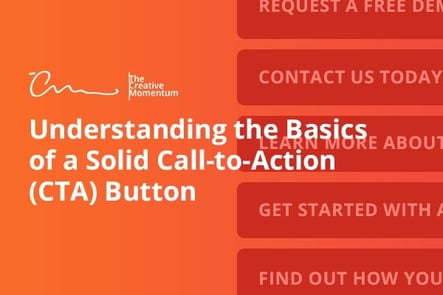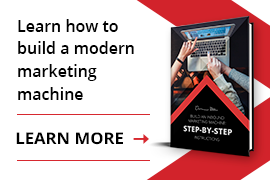
Realistically, calls-to-action are a large component of your content strategy. It's more than just throwing out a catchy one-liner. A solid CTAs fits seamlessly into the broader messaging of a campaign narrative. Before you get to work developing your Pulitzer Prize-winning ad copy, it’s worth reviewing the basics of what makes a good CTA.
What makes a good CTA?
Easy to Find
A good CTA isn’t a game of hide and seek. It’s clear, visible, and easy to find. There’s more than one way to go about a strategically placed CTA, but the two most popular locations are above the fold or the end of your copy. Going above the fold gives you the advantage of hitting your reader with the CTA before they bounce, in the event that it’s a drive-by click-through. Placing the CTA at the bottom of a page presents your CTA while the reader is digesting the ideas you’ve just shared and is more open to suggestion.
Aside from placement, some other considerations are space, color, and size. Utilizing space isolates the button so that it isn’t confused with other elements on the page. Using a contrasting color also helps it stand out. Finally, there’s a perfect balance to be struck between a CTA that’s large enough to be noticed but small enough to allow for the impact of your web design.
Stand-Alone
Do you want to subscribe now? How about now? Ok, what if I hang out over here? Just kidding – over here! Click me here!
Cut it out. The green eggs and ham approach isn’t going to win you any conversions.
Aside from looking tacky, desperate, and shady, overwhelming the user with countless CTAs creates a sense of fatigue. If you keep rewording and redesigning your CTAs to plaster them all over your web page, you’re not creating variety; you’re cultivating confusion. You can’t pound your buyer into submission. She or he is just going to bounce, so stick to one strong CTA over a shotgun approach and a Hail Mary.
Easily Identifiable
It should also look like a CTA. It might be tempting to get creative and incorporate your call-to-action into an image or a nav bar, but you’re not winning over any clients that way. Make it look like a button. Make the language clear.
Results-Oriented
While we’re on the topic of language, compelling CTAs are results-oriented rather than task oriented.
The most honest CTAs would read “Buy My Thing” over and over again. A lot of us would be out of business if life were that easy. We’re shooting to be a little more tactful, perhaps even enticing, if you would.
Enter: The results-oriented CTA.
As the name suggests, focus on what the request from the CTA accomplishes rather than the request itself. Users already understand that you’re asking for a subscription, purchase, or sign-up. A good CTA tells them what they get in return.
A task-oriented CTA would read “Sign Up For More Gardening Tips.” A results-oriented CTA would read “Grow Tomatoes the Size of Your Head.”
Just think of all that marinara…
Smooth and Succinct
More language tips: keep it short and don’t use friction words.
First off, buttons with long text are visually appalling. At some point it stops even looking like a button, at which point you’ve lost a key factor of being an easily identifiable CTA. Sometimes it’s tough to explain your offer in 5 words or less, but that’s why there’s a whole web page at your disposal. You can include an elaboration on your offer with copy above, below, or surrounding the button. There’s no need to crowd things up. That said, you’re better off if you can get the offer across with less distraction around the CTA.
As for friction words, these were hinted at in the previous point. Results-oriented is preferable. Friction words are toxic copy. These include anything that your user has to give up – things they don’t want to do. Friction words include: subscribe, buy, donate, submit, etc. The list goes on. While it’s technically a “call-to-action,” you, instead, want to present it as an offer of service.
Tailored
A good CTA also knows what it is. What is the action that you’re looking for? Is it to nurture leads? To build social media engagement? To close a sale?
Different kinds of CTAs call for different approaches in regards to placing, design, and copy. Social media share buttons are ubiquitous and self-explanatory. As soon as users see the little bird or that precarious “f,” they know what they’re in for. At the same time, you don’t want social media share buttons interfering with copy, user text fields, or other CTAs. The standard practice is visible, but unobtrusive at the bottoms of pages.
Purchase and lead nurturing generally require a little more explanation. Lead nurturing CTAs in particular need to provide an incentive to the user and make it clear that they’re not dishing out cash. Purchase closers generally come late in the sales journey and may or may not require additional elaboration. In both cases, you can utilize copy on the rest of the page or near the CTA to explain why they really need to click that button.
Contextually-Relevant
With a better understanding of the basics of a solid CTA, you’re ready to delve into a little more nuance.
There are a number of perks to planning out your content strategy before campaign launch. One of the major ones is developing a consistent brand narrative for your editorial calendar. A quality content marketing strategy plans for the kind of CTAs that will pop up throughout the campaign and the messaging that they will convey. These kinds of CTAs are contextually relevant – both to their immediate context and the larger messaging of a content campaign.
And with that, you’re ready to make your first foray into the intrepid world of CTA design. Make it visible, coherent, and succinct. Use your copy carefully, and – above all else – put some thought into your CTAs!

